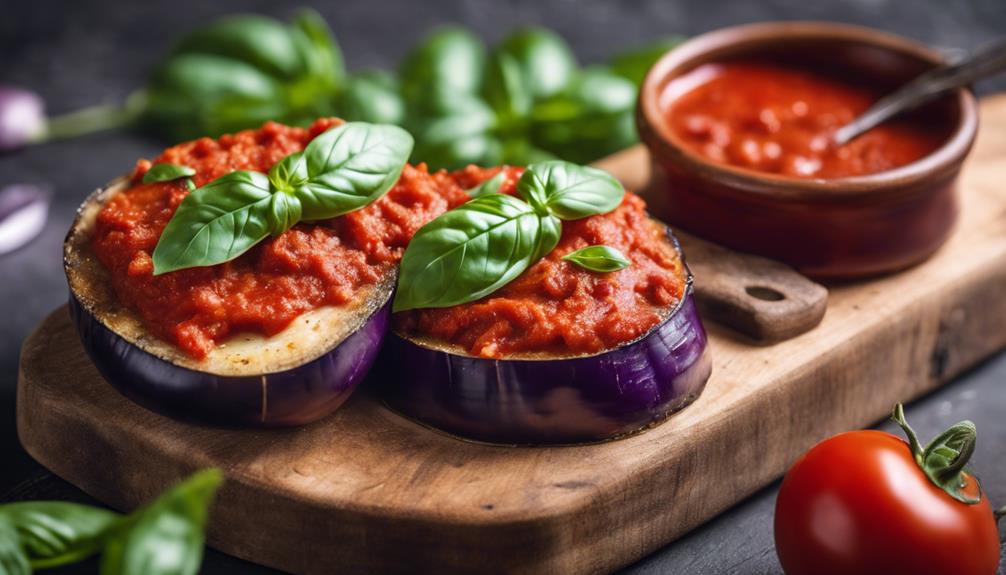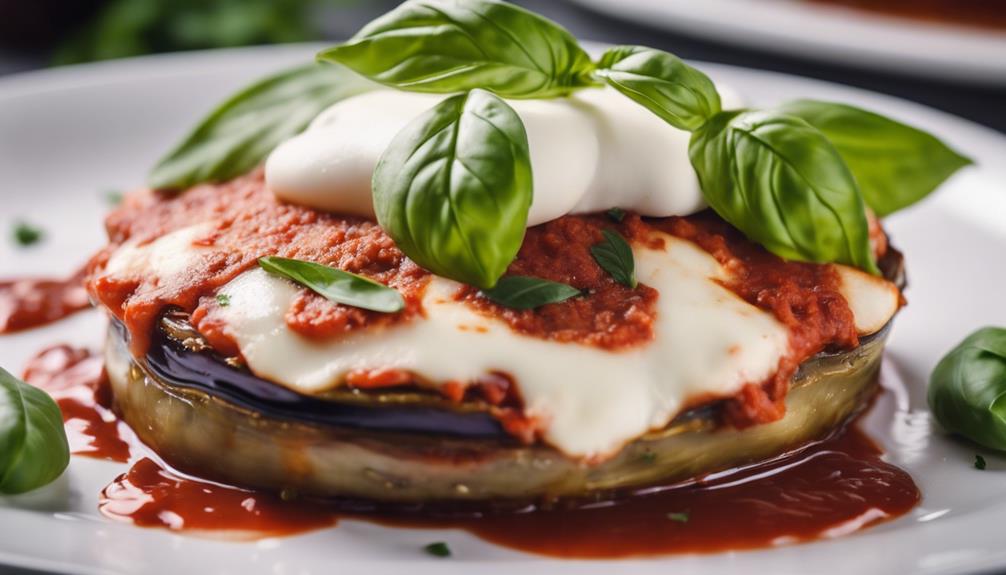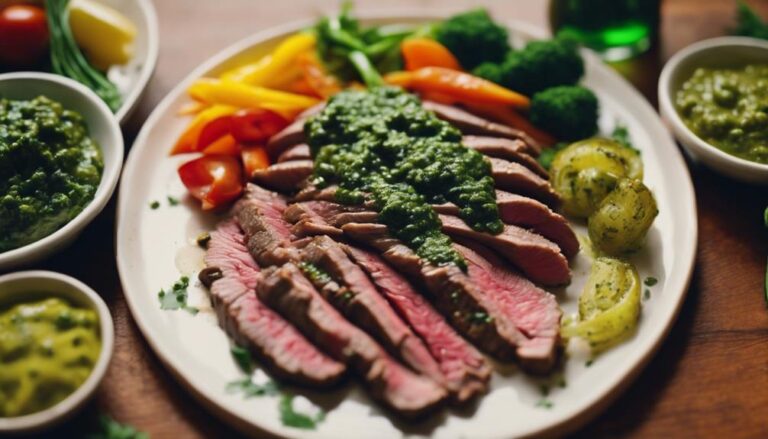Sous Vide Eggplant Parmesan With Fresh Basil
Plunge into a succulent Sous Vide Eggplant Parmesan, brimming with the zesty kick of fresh basil. Embark by vacuum-sealing eggplant slices with seasonings for a juicy finish. Roast until tender in the vacuum-sealed bag, then layer with marinara, mozzarella, and parmesan for a melty masterpiece. The sous vide method guarantees a flawless texture in every bite. Your taste buds will thank you for this delectable dish that's a feast for the senses. Experience a culinary journey like no other with the vibrant flavors of this modern take on a timeless classic. Uncover the secrets to mastering this mouthwatering recipe.
What You Will Learn Here
- Sous vide method ensures even cooking and optimal flavor absorption.
- Fresh basil enhances the dish with a burst of freshness.
- Eggplant slices should be uniform for consistent cooking.
- Finish with basil for elevated taste and visual appeal.
- Sous vide cooking preserves nutrients and enhances flavors.
Eggplant's Ancient Culinary Roots

Eggplant's culinary journey spans over 4,000 years, originating in India before making its way to the Middle East and Mediterranean regions.
This versatile vegetable was highly esteemed by ancient civilizations like the Egyptians and Persians for its culinary prowess and medicinal qualities.
The evolution of eggplant's taste and varieties has played a significant role in shaping its place in different cuisines worldwide.
Culinary History of Eggplant
Having roots in ancient India and Southeast Asia, eggplant has a rich culinary history that spans centuries and continents, influencing diverse cuisines worldwide. The journey of the eggplant began in India and Southeast Asia, where it was first cultivated and appreciated for its unique flavor and versatility in cooking. Over time, the eggplant found its way to the Mediterranean region through Arab traders during the Middle Ages, becoming a staple in Mediterranean cuisine. By the 16th century, it had made its mark in Europe and was widely embraced for its culinary potential. The eggplant's ability to adapt to various cooking methods led to its inclusion in iconic dishes like the Italian Eggplant Parmesan and Middle Eastern baba ghanoush.
| Culinary History of Eggplant | |
|---|---|
| Origin: | India and Southeast Asia |
| Middle Ages: | Introduced to the Mediterranean region by the Arabs |
| 16th Century: | Spread to Europe |
| 18th Century: | Widely cultivated and incorporated into traditional dishes |
| Present: | Featured in global cuisines for its unique flavor and texture |
Eggplant in Different Cuisines
With its ancient culinary roots dating back to 5th century India, eggplant has traveled across continents and cultures, leaving its flavorful mark on dishes worldwide.
In Italian cuisine, eggplant shines in the beloved Eggplant Parmesan, where slices are breaded, fried, then baked with tomato sauce and melted cheese. This dish highlights eggplant's ability to absorb flavors and textures, creating a satisfying meal.
Another technique gaining popularity is water immersion, where the eggplant is soaked to reduce bitterness and enhance its texture.
In Greek moussaka, Middle Eastern baba ganoush, or Asian dishes like Szechuan eggplant and nasu dengaku, eggplant's versatility is showcased through various cooking methods.
Whether grilled, roasted, stir-fried, or baked, eggplant's adaptability makes it a star ingredient worldwide.
Eggplant Nutritional Benefits
Rich in fiber, vitamins, and minerals like potassium and vitamin C, eggplant offers a nutritious addition to your diet with its low-calorie content and antioxidant-rich skin.
The antioxidants found in eggplant, such as nasunin in the skin, play an important role in protecting cells from damage caused by free radicals.
This versatile vegetable not only provides essential nutrients but also adds depth to various dishes.
Ancient culinary roots dating back to around 544 AD showcase the long-standing presence of eggplant in different cuisines.
As a member of the nightshade family, which includes tomatoes and potatoes, eggplant brings a unique flavor profile and texture to meals.
Purple Eggplant Slices

For optimal results when preparing purple eggplant slices for Sous Vide Eggplant Parmesan, make sure to properly salt, rinse, and dry them to eliminate bitterness and excess moisture before the sous-vide process.
- Salt & Rinse: Sprinkle salt over the eggplant slices to draw out bitterness. After about 30 minutes, rinse the salt off thoroughly under cold water.
- Dry Thoroughly: Pat the rinsed eggplant slices dry with paper towels to remove excess moisture. This step ensures a better texture after sous-vide cooking.
- Uniform Slicing: Ensure the eggplant slices are cut evenly to promote consistent cooking during the sous-vide process.
Properly preparing the purple eggplant slices sets the foundation for a successful Sous Vide Eggplant Parmesan dish. By following these steps, you can enhance the flavor and texture of the eggplant, allowing it to shine alongside the fresh basil and melted cheeses in this classic recipe.
Eggplant Parmesan Variations
When exploring Eggplant Parmesan variations, consider trying:
- Breaded eggplant slices with melted mozzarella.
- Herbed breadcrumb eggplant stacks for added crunch.
- Herbed eggplant Parmesan roll-ups for a twist on presentation.
Each variation brings a unique blend of textures and flavors to the classic dish, offering a personalized touch to suit your taste preferences.
Experimenting with different ingredients and cooking methods can elevate your Eggplant Parmesan experience and introduce exciting new flavors to your meal.
Breaded Eggplant Slices With Mozzarella
Consider layering thinly sliced eggplant coated in crispy breadcrumbs with gooey melted mozzarella to create a delectable twist on the classic Eggplant Parmesan dish.
This variation introduces a delightful contrast between the crunchy breading and the smooth, creamy cheese. The breading not only adds a satisfying crunch but also locks in the moisture of the eggplant, ensuring a tender bite in every mouthful.
The fresh mozzarella melts beautifully, creating strings of cheesy goodness that perfectly complement the savory tomato sauce. This combination of textures and flavors elevates the dish to a whole new level of indulgence.
Whether as a side or a main course, this breaded eggplant slices with mozzarella dish is sure to impress with its rich and satisfying taste.
Herbed Breadcrumb Eggplant Stacks
Enhance your traditional Eggplant Parmesan recipe with a delightful twist by creating visually appealing Herbed Breadcrumb Eggplant Stacks.
These stacks offer a modern take on the classic dish while adding a crunchy texture and a burst of flavor to each bite.
Stacking the eggplant slices with herbed breadcrumbs not only elevates the presentation but also enhances the overall taste profile with a blend of aromatic herbs and seasonings.
The herbed breadcrumb coating creates a layer of complexity, making each stack a delicious and satisfying option for a meal.
Try these Herbed Breadcrumb Eggplant Stacks for a fresh and innovative approach to enjoying eggplant in a delightful and flavorful way.
Herbed Eggplant Parmesan Roll-Ups
For a tantalizing twist on the classic Eggplant Parmesan, explore the delectable world of Herbed Eggplant Parmesan Roll-Ups. These roll-ups feature thinly sliced eggplant rolled with a flavorful herbed filling, typically including ricotta cheese, Parmesan, basil, and oregano.
Baked in marinara sauce until tender, they offer a unique and elegant presentation that's sure to impress your guests. The combination of the savory herbed filling and the tender eggplant creates a delightful flavor experience that adds variety to your menu.
Whether as a main dish or a side, these roll-ups are a creative way to elevate the traditional Eggplant Parmesan and bring a touch of sophistication to your table.
Slicing Eggplant for Even Cooking
To achieve evenly cooked eggplant in your dish, it's important to slice the eggplant into uniform 1/4-inch-thick rounds. Maintaining consistent thickness throughout the slices is vital as it guarantees that each piece cooks at the same rate.
This precision in slicing guarantees that your eggplant Parmesan will have a perfectly balanced texture and flavor profile.
Uniform Eggplant Slices
Achieve consistent results in your Sous Vide Eggplant Parmesan recipe by ensuring that your eggplant slices are uniformly thick for even cooking throughout the process. When slicing the eggplant, aim for slices of equal thickness to guarantee that each piece cooks at the same rate. This uniformity will prevent some pieces from becoming overcooked while others remain undercooked.
Thicker slices may require a longer cooking time in the sous vide bath, while thinner slices may cook faster, so be mindful of the thickness to maintain the desired texture. Additionally, uniform slices not only aid in even cooking but also contribute to a visually appealing presentation of your dish.
Consistent Thickness Important
Maintain consistent thickness in your eggplant slices to guarantee uniform cooking results in your Sous Vide Eggplant Parmesan recipe. Slicing the eggplant onto uniform thickness ensures that each piece cooks evenly, preventing some from being underdone while others are overcooked. This precision leads to a cohesive texture and balanced flavor in every bite. Additionally, uniformly sliced eggplant allows for a visually appealing presentation, enhancing the overall dining experience. By investing time in slicing the eggplant consistently, you contribute to the success and quality of the sous vide cooking process, ultimately elevating the taste and texture of your final dish.
| Importance of Consistent Thickness | |
|---|---|
| Ensures even cooking throughout | Prevents undercooked or overcooked pieces |
| Contributes to balanced flavor | Enhances visual appeal |
| Improves overall taste and texture |
Even Cooking Time
For consistent and even cooking of your Sous Vide Eggplant Parmesan, make sure that your eggplant slices are uniformly cut to the same thickness. When the eggplant is finished cooking, slices of consistent thickness will guarantee that each piece is perfectly tender and cooked through.
Thicker slices may result in some parts being undercooked while others are overdone. Thinner slices can cook too quickly, leading to uneven textures. To achieve a balanced dish, aim for slices that are around 1/4 inch thick. This thickness allows the eggplant to cook evenly, absorbing the flavors of the sauce and cheese.
After slicing, pat dry the eggplant slices to remove excess moisture before cooking for the best results.
Final Thoughts
In considering the final thoughts on the sous vide eggplant parmesan recipe, the role of fresh basil emerges as a pivotal element that elevates both the flavor and visual appeal of the dish. The fragrant and herbaceous notes of the fresh basil infuse each bite with a burst of freshness that complements the rich layers of eggplant, marinara sauce, and cheese. The flavor profile created by the combination of basil with these ingredients is nothing short of harmonious and delicious, offering a symphony of tastes on the palate.
Moreover, garnishing the sous vide eggplant parmesan with fresh basil leaves not only adds to the dish's visual appeal but also hints at the aromatic essence that lies within. The vibrant green of the basil against the backdrop of the golden-brown cheese and deep red marinara sauce creates a visually stunning presentation that promises a delightful culinary experience. The marriage of basil's fragrance with the savory components of the dish truly elevates the overall taste experience, making each bite a celebration of flavors.
Frequently Asked Questions
How Do You Keep Eggplant Parmesan From Getting Soggy?
To keep eggplant parmesan from getting soggy, guarantee a crispy coating by breading and frying the slices before layering. Drain excess liquid post-cooking, layer sparing sauce, and top with cheese. This method maintains texture during baking.
Do You Leave the Skin on Eggplant for Eggplant Parmesan?
When making eggplant parmesan, keep the skin on for added texture and nutrients. However, peeling can result in a smoother dish. Your choice depends on your preference for texture and visual appeal, influenced by individual taste and cooking methods.
Should I Salt Eggplant Before Making Eggplant Parmesan?
Yes, you should salt the eggplant before making eggplant parmesan. This salting technique not only extracts moisture to prevent sogginess but also enhances flavor. Experiment with different seasoning options and cooking times for varied textures in this traditional dish.
What Happens if You Don't Salt Eggplant Before Cooking?
If you skip salting eggplant, you risk a watery dish affecting eggplant texture. Absence of salt absorption leads to bitterness and longer cooking time. Proper salting is key for great texture and flavor in dishes.
Conclusion
Indulge in the rich flavors of this sous vide eggplant parmesan with fresh basil.
The tender eggplant slices, perfectly cooked using the sous vide method, are layered with savory marinara sauce and gooey cheese for a delightful twist on a classic dish.
The fresh basil adds a burst of herbaceous freshness that elevates the flavors to a whole new level.
Treat yourself to this gourmet experience and enjoy a truly unforgettable meal.











